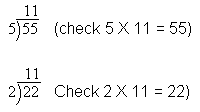Division (Continued)
In the last session we looked at breaking up products into smaller groups i.e. division.
We also have looked at the symbols we use:
Break 16 into groups of 4 how many groups have we got?
...is written in shorter form as 16 divide by 4
...in symbol form as 16 ÷ 4
There is an alternative short method:
![]()
This means 16 divide by 4 as well, (remember the number you want to break
up (divide) is inside the box).
Today I will take you through a few simple division examples just to get you used to the method and self checking your work. I will take you through step by step.
Here is a division sum:
![]()
Step 1 We have asked how many 3's in 3 and put the answer 1 above the 3.
Step 2 We have asked how many 3's in 9 and put the answer 3 above the nine.
There is nothing remaining so that is our answer (we think).
Step 3 We always check our work, so now we multiply 13(answer) by 3 (the question).
13 X 3 = 39.
Notice how we get back to the number in the box. This means that our answer is right.
Try the next one for yourself:
![]()
![]()
And the check: 12 (answer) X 4 = 48.
48 was the number we divided up.
By doing this check we can see straight away if our answer is right. Since the answer is the number we started with we know it is correct.
Well, how did you do with that?
Try the next few and don't forget to check them before you look at the answers. You may already know the answers to these. It does not matter, what matters is the process.
![]()

Here are the rest of the answers
44 ÷ 2 = 22 (check 2 X 22 = 44)
77 ÷ 7 = 11 (check 7 X 11 = 77)
66 ÷ 3 = 22 (check 3 X 22= 66).
Well that is it for today. I really want you to ensure that you follow the method and more importantly always check your answers.
Good luck!